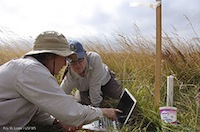 The purpose of a Phase 1 site assessment is to determine whether “recognized environmental conditions” exist anywhere on the property in question. That includes structures as well as the soil itself, and also surface or ground water. This assessment is usually performed at the time a property is up for sale, to ensure the prospective new buyer knows exactly what they’re purchasing and to provide certain legal protections.
The purpose of a Phase 1 site assessment is to determine whether “recognized environmental conditions” exist anywhere on the property in question. That includes structures as well as the soil itself, and also surface or ground water. This assessment is usually performed at the time a property is up for sale, to ensure the prospective new buyer knows exactly what they’re purchasing and to provide certain legal protections.
A recognized environmental condition is defined as demonstrable or probable presence of a petroleum product or a hazardous substance and evidence that either the contamination was caused by a past or current release or there is a significant threat of a release occurring. Applicable hazardous substances are identified by the Comprehensive Environmental Response, Compensation & Liability Act, more commonly known as CERCLA.
How does the Phase 1 site assessment work?
It’s designed to be a first-step investigation, officially referred to as “all appropriate inquiry” into the property’s history and current condition. The Phase 1 site assessment is an overview, but it includes enough detailed research and analysis to determine whether the property is safe and clean or if additional testing is warranted to clarify the extent of contamination that is discovered.
The assessment must be conducted by a certified technician. It’s smart to work with a team of environmental engineers, because they have the professional training and expertise as well as day-to-day experience working with hazardous chemicals and related processes. They know what to look for. Most importantly, they’re scientists, so they know which tests are appropriate for this initial phase and how to properly interpret the results.
Environmental professionals can conduct your Phase 1 site assessment thoroughly and accurately and as quickly as possible, not just complying with regulations but giving you a final report that gives you a clear picture of the property’s condition. They’re also in the best position to help you develop a constructive but cost-effective remediation plan, should that be necessary.
Exactly what will they do to uncover recognized environmental conditions?
Your Phase 1 site assessment team will try go back as far into the past as possible to learn about how the property has been used. Certain kinds of businesses are far more prone to storing and handling potentially dangerous substances, so it’s important to know if those types of businesses have been associated with this land. It could be anything from a dry cleaner or photographic shop to a manufacturing or other industrial company.
To do that, they will:
- Research official records on file with local, state, regional, federal or even tribal agencies that would confirm past discovery of contamination and how it was addressed.
- Research publicly-available material such as newspaper articles or similar documents as well as maps and aerial photos that show the property. They’ll look in old phone books or other directories to find business connections.
- Talk with current and past owners and/or managers. Those most closely associated with the property day in and day out usually know about the presence of hazardous chemicals or may suspect contamination has occurred.
- Visit the property, to visually inspect the land and any structures. They’ll also take a cursory look at any adjacent property, because contamination can migrate to or from your property through soil or water. Identifying the source of contamination is as important as identifying the type.
- Take soil or water samples and perform basic testing.
You’ll be given a final report that details the process and findings of your Phase 1 site assessment. With luck, it will give your property a clean bill of health and you can proceed confidently. If a recognized environmental condition is found, you’ll have a good idea of what chemicals are present and to what extent, so you can work toward a remediation solution.
Photo Credit: USFWS Pacific via Flickr
